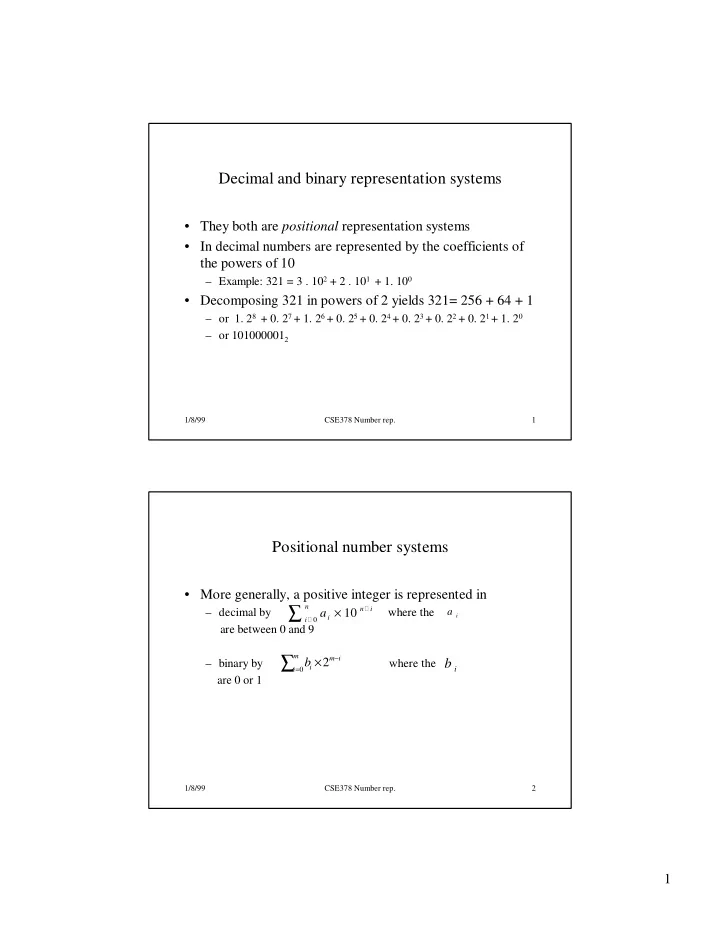

Decimal and binary representation systems • They both are positional representation systems • In decimal numbers are represented by the coefficients of the powers of 10 – Example: 321 = 3 . 10 2 + 2 . 10 1 + 1. 10 0 • Decomposing 321 in powers of 2 yields 321= 256 + 64 + 1 – or 1. 2 8 + 0. 2 7 + 1. 2 6 + 0. 2 5 + 0. 2 4 + 0. 2 3 + 0. 2 2 + 0. 2 1 + 1. 2 0 – or 101000001 2 1/8/99 CSE378 Number rep. 1 Positional number systems • More generally, a positive integer is represented in ∑ n × � n i – decimal by where the a 10 a i � i i 0 are between 0 and 9 ∑ − m × m i b 2 – binary by where the b = i i i 0 are 0 or 1 1/8/99 CSE378 Number rep. 2 1
Binary and Hexadecimal representation systems • Writing binary numbers quickly becomes error-prone and unwieldy • Instead use hexadecimal system, positional representation system in base 16 – Example: 321 = 1 .16 2 + 4 .16 1 + 1 .16 0 = 141 16 • Since the coefficients are between 0 and 15, we need new symbols to represent 10 through 15. They will be A through F – A (hex) = 10 (decimal) = 1010 (binary) – B (hex) = 11 (decimal) = 1011 (binary) ... – F (hex) = 15 (decimal) = 1111 (binary) 1/8/99 CSE378 Number rep. 3 Conversion between binary and hexadecimal • Group bits (abbreviation for binary digits) by groups of four, starting from the right ( least significant bit or lsb ) – Example: 101000001 = 1 0100 0001 (binary) = 141 (hex) – 111001011 = 1 1100 1011 (binary) = 1CB (hex) – Note that the greatest magnitude bit , the leftmost one, is called ( most significant bit or msb) • Why hexadecimal? – Very convenient to represent strings of 4, 8, …,16,…32, …64 bits by 1,2,..,4,…8….16 hex digits 1/8/99 CSE378 Number rep. 4 2
Some useful powers of two = ≈ = 10 3 2 1024 10 1 K 10 ≈ = 20 6 2 10 1 M ≈ = 30 9 2 10 1 G • We’ll often round-off and talk about, say, 16 KB or 64 MB 1/8/99 CSE378 Number rep. 5 Representing positive and negative integers • In an n -bit register, you can represent 2 n patterns – Example: in a 32-bit register, we can represent unsigned integers in the range [0:2 32 -1] • How to represent positive and negative integers with the following properties: – Equal number of positive and negative numbers – Unique (and easily testable) representation of zero – Easy sign test – Easy rules for addition and subtraction 1/8/99 CSE378 Number rep. 6 3
Three representation systems • Historically, 3 different numbering systems have been used – Two’s complement now used in all machines for integer representation – sign and magnitude used (partially) for floating-point representation – One’s complement (very similar to 2’s complement but with a few more drawbacks) 1/8/99 CSE378 Number rep. 7 Two’s complement representation • Positive numbers as unsigned binary with msb always 0 • Zero is represented as a string of 0’s • To represent a negative number: – Consider the representation of its absolute value – Flip all 1’s to 0’s and 0’s to 1’s (this is 1’s complement) – Add 1 to lsb using binary arithmetic rules 1/8/99 CSE378 Number rep. 8 4
2’s complement • Example assuming a 4-bit register – What is the representation of (decimal) 6? – What is the representation of (decimal) -6? – What is the representation of 0? – What is the range of representation of positive numbers? – What is the range of representation of negative numbers? – How do I recognize whether a number is positive or negative or zero? 1/8/99 CSE378 Number rep. 9 Addition in 2’s complement • Addition – Perform an ordinary binary addition and discard the carry-out – If you add 2 numbers of opposite sign, everything will always be all right – If you add two positive numbers and the result appears to be negative (i.e., msb = 1) then you have an overflow. This will generate an exception in your program. – If you add two negative numbers and the result appears to be positive (i.e., msb = 0) then you have an underflow. • Subtraction – Take the 2’s complement of the subtrahend and add it to the other operand 1/8/99 CSE378 Number rep. 10 5
Recommend
More recommend